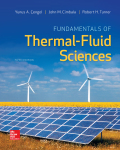
The rate of entropy generation during the process.
Explanation of Solution
Given:
The inlet pressure of the water
The inlet temperature of the water
The mass flow rate of water
The inlet pressure of the steam
The inlet temperature of the steam
The heat lost to the surroundings
The surrounding temperature of the air
Calculation:
Refer to Table A-4E, “Saturated water—Temperature table”, obtain the below properties at the pressure of
The fluid entropy
The fluid enthalpy
Refer to Table A-4E, “Saturated water—Temperature table”, obtain the below properties at the pressure of
The entropy at inlet 2
The enthalpy at inlet 2
Refer to Table A-4E, “Saturated water—Temperature table”, obtain the below properties at the pressure of
The entropy at exit 3
The enthalpy at exit 3
Write the expression for the energy balance equation for closed system.
Here, rate of net energy transfer in to the control volume is
Substitute 0 for
Here, mass flow rate at inlet 1 is
Substitute
The rate of change in internal energy of the system is zero at steady state,
Write the expression for the mass balance of the system.
Here, inlet mass flow rate is
Substitute
Write the expression for the entropy balance during the process.
Here, rate of net input entropy is
Substitute
Thus, the rate of entropy generation during the process is
Want to see more full solutions like this?
Chapter 8 Solutions
EBK FUNDAMENTALS OF THERMAL-FLUID SCIEN
 Elements Of ElectromagneticsMechanical EngineeringISBN:9780190698614Author:Sadiku, Matthew N. O.Publisher:Oxford University Press
Elements Of ElectromagneticsMechanical EngineeringISBN:9780190698614Author:Sadiku, Matthew N. O.Publisher:Oxford University Press Mechanics of Materials (10th Edition)Mechanical EngineeringISBN:9780134319650Author:Russell C. HibbelerPublisher:PEARSON
Mechanics of Materials (10th Edition)Mechanical EngineeringISBN:9780134319650Author:Russell C. HibbelerPublisher:PEARSON Thermodynamics: An Engineering ApproachMechanical EngineeringISBN:9781259822674Author:Yunus A. Cengel Dr., Michael A. BolesPublisher:McGraw-Hill Education
Thermodynamics: An Engineering ApproachMechanical EngineeringISBN:9781259822674Author:Yunus A. Cengel Dr., Michael A. BolesPublisher:McGraw-Hill Education Control Systems EngineeringMechanical EngineeringISBN:9781118170519Author:Norman S. NisePublisher:WILEY
Control Systems EngineeringMechanical EngineeringISBN:9781118170519Author:Norman S. NisePublisher:WILEY Mechanics of Materials (MindTap Course List)Mechanical EngineeringISBN:9781337093347Author:Barry J. Goodno, James M. GerePublisher:Cengage Learning
Mechanics of Materials (MindTap Course List)Mechanical EngineeringISBN:9781337093347Author:Barry J. Goodno, James M. GerePublisher:Cengage Learning Engineering Mechanics: StaticsMechanical EngineeringISBN:9781118807330Author:James L. Meriam, L. G. Kraige, J. N. BoltonPublisher:WILEY
Engineering Mechanics: StaticsMechanical EngineeringISBN:9781118807330Author:James L. Meriam, L. G. Kraige, J. N. BoltonPublisher:WILEY





